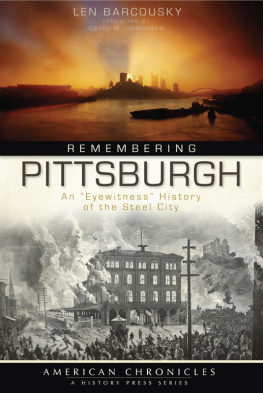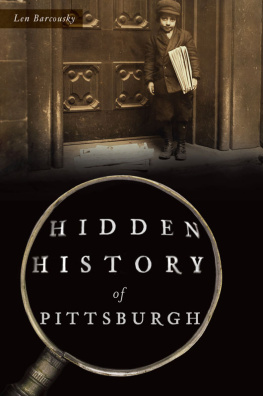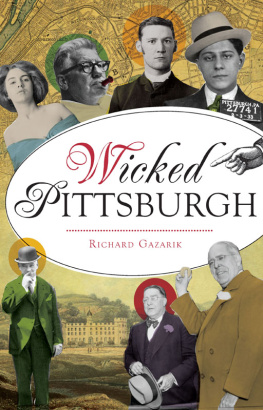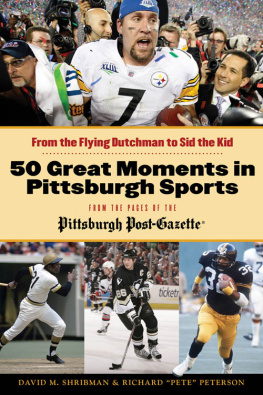

Published by The History Press
Charleston, SC 29403
www.historypress.net
Copyright 2010 by Len Barcousky
All rights reserved
Front cover images: Pittsburgh at dawn, Darrell Sapp of the Pittsburgh Post-Gazette; Union Depot, Senator John Heinz History Center. Back cover images: statue, Robin Rombach of the Pittsburgh Post-Gazette; balloon, Pittsburgh Press; and Roosevelt rally, Pittsburgh Post-Gazette.
First published 2010
e-book edition 2012
ISBN 978.1.61423.272.8
Library of Congress Cataloging-in-Publication Data
Barcousky, Len.
Remembering Pittsburgh : an eyewitness history of the Steel City / Len Barcousky.
p. cm.
Collection of authors historical columns from the Pittsburgh Post-Gazette.
Includes bibliographical references and index.
print edition ISBN 978-1-60949-008-9
1. Pittsburgh (Pa.)--History. I. Title.
F159.P657B37 2010
974.886--dc22
2010020921
Notice: The information in this book is true and complete to the best of our knowledge. It is offered without guarantee on the part of the author or The History Press. The author and The History Press disclaim all liability in connection with the use of this book.
All rights reserved. No part of this book may be reproduced or transmitted in any form whatsoever without prior written permission from the publisher except in the case of brief quotations embodied in critical articles and reviews.
For my wife Barbara, who keeps me on an even keel.
CONTENTS
FOREWORD
STORIES THAT TRAVEL
We print the present, or what just happened. Many social and literary critics believe that the daily newspaper is history, but history is what we seldom offer. More often we write about what happened yesterdayor, on the Web, a few minutes agoand on rare occasions we look back at an event or a trend to write about how it developed. But in almost no case can modern American newspapers be regarded as deep explorers of history.
The presence of the word almost in the last sentence was no accident, because one of the most endearing aspects of the Pittsburgh Post-Gazette is its respect for, and exploration of, history even as the newspaper and its Website strive to produce a lively, contemporary news report, focusing on what happened yesterday, an hour ago or a few minutes ago. Here at the Post-Gazette, we look backward and forward at the same time. Its more than our niche; its part of our character.
And its a result of the characters we have on this remarkable staff. One of them is Len Barcousky, who by day is one of the sharpest, shrewdest reporters on any newspaperanywhere. He believes deeply in newson finding out what just happened. But he believes, too, in going deeperin understanding why things happened. He searches for what is coming next, to be sure. But he also searches for what came before.
Len Barcousky is an unusual newspaper reporter, which is in part why the Post-Gazette is an unusual newspaper. We believe we have a role in the future, but we also believe the past has a role in our lives. Not a week goes by in the Post-Gazette without an important story about something that didnt happen yesterday. I insist on it. More important, our readers insist on it.
Let me say something about what we normally produce in the course of every day: stories with a short shelf life. Because if there is one truth about newspapering it is this: newspaper stories dont travel. Sure, you can cut them out and send them across the country in an envelope. (Memo to college students: Your parents can explain how that works.) Or you can zap them across town on your computer or portable device. But when I say newspaper stories dont travel, I mean that they dont travel in time. The only thing staler than yesterdays politician is news about yesterdays politician. Pick up an old newspaper at an estate sale or an antique store and you will be captivatedby the ads, not the stories. Our stories are like fresh bread from one of Pittsburghs signature bakeries: No preservatives. Stale after a short while.
Thats another reason why Len Barcousky stands out. He writes stories that stick around. You dont have to read them on Sunday morning in their reliable spot on the second page of the paper. You can read them the next day, the next week or the next year. The past doesnt change, which is why Len is probably the only member of our staff whose stories would fit comfortably between covers of a book. Yesterdays kerfuffle over property tax rates or last weeks contretemps in city council are soon forgottenin many cases for good reason. Not so the stories in this book. They hang around with us, in large measure because their effects hang with us for decades, even centuries.
So open this book and hang with it for a while. You might put it down for a bit, but youll pick it up again. Guaranteed. These are not the stories of your life. They are the stories that created the stories of your life. In this case, the past is a great presentto us all, from one of Pittsburghs great storytellers. But then again, he had great material.
David M. Shribman is executive editor of the Post-Gazette.
He was awarded the Pulitzer Prize in 1995 for his coverage of Washington.
ACKNOWLEDGEMENTS
A booklike victoryhas many fathers and mothers. This one became possible with the support of many parents. I am grateful to the top editors at the Pittsburgh Post-Gazette, especially publisher and editor in chief John Robinson Block and executive editor David M. Shribman. They both are committed to running stories that examine and seek to explain our past. I also am grateful to my immediate supervisors. They have included several north bureau chiefs and suburban editors who gave me time and encouragement to work on these pieces. Thanks also to the editors who have overseen the Post-Gazettes Page 2 featuresDavid Michelmore, John Allison and Gary Rotsteinwhere most of these stories originally appeared. I appreciate the good work of the newspapers copy editors. They have challenged me and improved these accounts. Allison Alexander, the newspapers marketing services manager, helped to work out the terms of the contract that turned columns into a book.
No good work on Pittsburgh history could be done without aid from excellent local libraries and their skilled librarians. Their ranks include Angelika Kane and Steve Karlinchak at the Post-Gazette and head librarian Art Louderback and chief archivist David Grinnell at the Senator John Heinz History Center. Reference staff members in the Pennsylvania Room at the Carnegie Library of Pittsburgh also have been helpful on my many trips to that institution.
Post-Gazette photography is an important part of this book. I have gotten excellent cooperation from Andy Starnes, John Heller, Robin Rombach and Jim Mendenhall.
I am grateful to my wife, Barbara, and my children, Peter and Sarah, who have listened patientlymostlywhen I returned from the Carnegie Library, eager to talk about my latest discoveries among the rolls of microfilm.
My greatest debt, however, is to the mostly anonymous reporters who have covered Pittsburgh for more than two centuries. Their first impressions of events great and small provide glimpses into the lives of those of us who have been lucky enough to live near the Forks of the Ohio.
PREFACE
FINDING THE FIRST DRAFTS OF PITTSBURGH HISTORY
For the past several years, I have been squinting at often-fuzzy microfilm in search of firsthand reports on life in Pittsburgh over the past two centuries.
Next page













